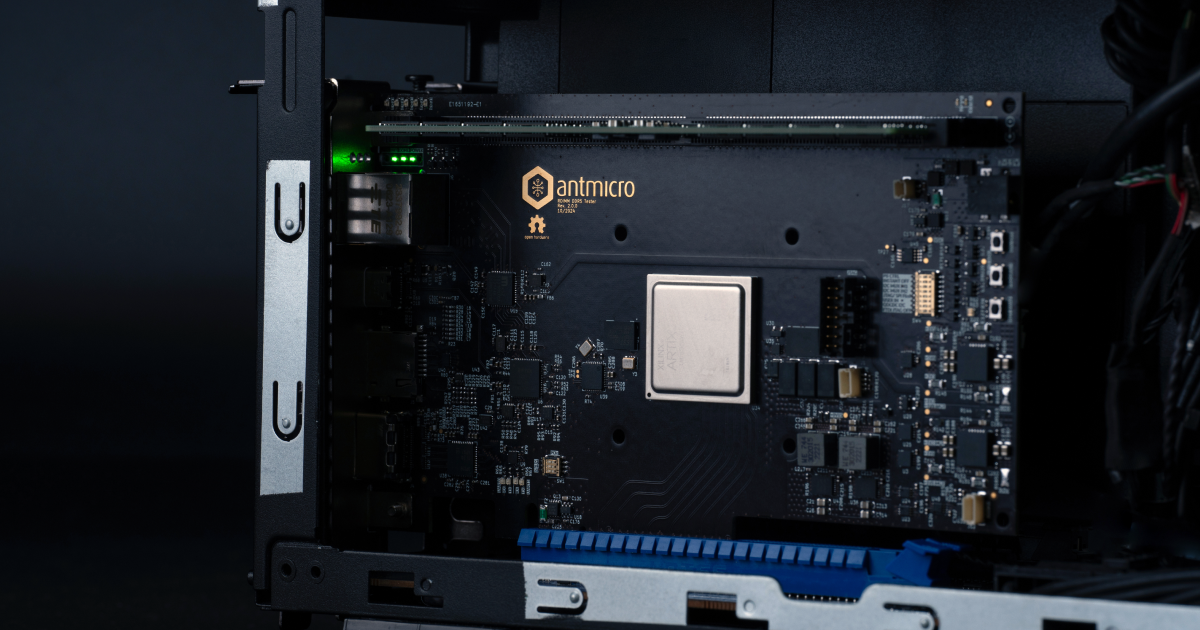High-Throughput Open Source PCIe on Xilinx VU19P-Based ASIC Prototyping Platform

This post was originally published at Antmicro.
In our daily work at Antmicro we use FPGAs primarily for their flexibility and parallel data processing capabilities that make them remarkably effective in advanced vision and audio processing systems involving high-speed interfaces such as PCI Express, USB, Ethernet, HDMI, SDI etc. that we develop and integrate as open source, portable building blocks. Many of our customers, however, use FPGAs also in a different context, namely for designing ASICs, which is a highly specialized market that typically involves large FPGAs, proprietary flows and IP. In one such project, we were working with one of the largest FPGAs in production today, the 9-million LUT Xilinx VU19. Being a design with considerable complexity, it needed a high-throughput link between the FPGA and the host PC that could be thoroughly benchmarked, analyzed and optimized for the use case.
Implementing PCIe with open source
Implementing PCIe is not completely straightforward as you have to synchronize multiple lines of high-speed bi-directional data. If you hit a bug somewhere in your data flow, things get very tricky to debug, especially if you have no ability to inspect and change the source code of the IPs involved. Being active developers of a variety of portable and reusable open source FPGA IP cores, for the project in question we were able to integrate a fully open PCIe interface into the Xilinx VU19-based ASIC prototyping platform using LiteX/LitePCIe, achieving a pretty respectable throughput of 31 Gbits/s on an 8-lane bandwidth. Although the FPGA chip itself is capable of 16-lane bandwidth for transferring data, the proFPGA board used in the setup supports only 8 lanes, but with hardware capable of bigger bandwidth we can achieve even greater throughput if needed. In fact, the repository also contains instructions for a 16-lane capable VU9-based setup – using a popular and not as prohibitively expensive devboard available from after-market- where we could measure as much as 59 Gbits/s.

Scalable, portable and customizable flows
Our ability to rapidly iterate as well as track down and fix bugs in the system we have created for this customer project demonstrates the scalability and portability of the open source-based approach, and is an example of Antmicro’s wider efforts aimed at developing reusable building blocks and introducing improvements to the whole FPGA ecosystem.
Open source-licensed IP cores play well with the open source FPGA and ASIC tooling that we are building to enable a faster, collaborative and modular system development workflow – a goal that is shared by CHIPS Alliance, of which we are proud to be a Platinum member. As one of the many examples, we are making great progress in enabling open source synthesis and simulation of complex SystemVerilog-based designs, such as security-focused RISC-V cores like OpenTitan’s Ibex. Some of our other projects focus on open source synthesis and place & route flows, linters, formatters, CI systems, simulation platforms, test suites and more.
Flexible system design
The PCIe core used in the ASIC prototyping project also works great in sophisticated computer systems we have been building for our customers. The wide array of customizable and licence-free FPGA IPs and SoC generators that we work with allows us to implement specific functionalities in the devices we build and it includes MIPI CSI and other camera interfaces, SDI, HDMI, ISP processing, video codecs, AI and 2D GPU acceleration, I2S, SPDIF, PCIe, USB, Ethernet, DMA, SATA and DRAM controllers.



